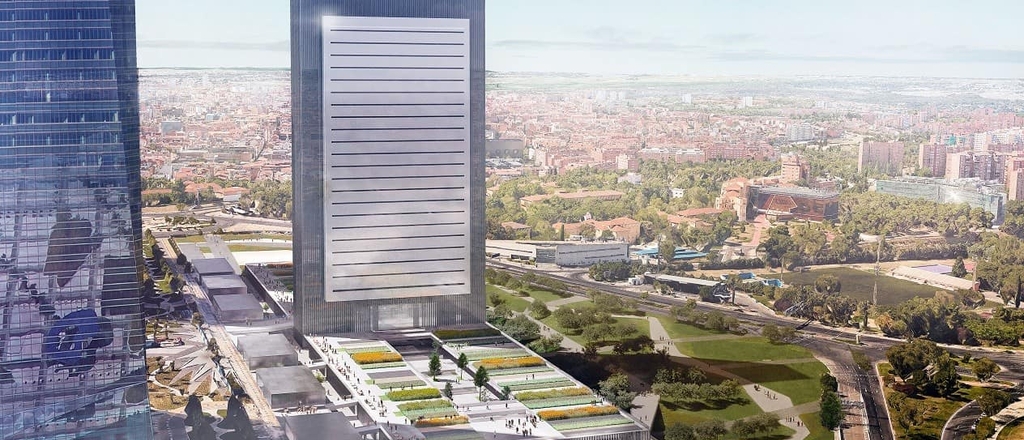- Home
- News And Events
- News
- Madrid's Fifth Tower Will House Ie University's New Center
Madrid's fifth tower will house IE University's new center

· Segovia-based IE University’s new complex will include a 165 meter high educational space with a surface area of 50,000 square meters, located in the north of Madrid
· The new complex will extend horizontally and vertically, and will comprise auditoriums, sports facilities, green areas and a 35-storey tower with classrooms and education zones
· IE will design innovative education spaces that integrate technology and pedagogy, replicating the working environments of the most disruptive companies and organizations in the world
· Madrid City Hall, Inmobiliaria Espacio and IE University will work together to ensure the project dovetails with the needs of the city of Madrid
IE University, ranked among the top universities in the world for both undergraduate and graduate programs, is set to expand its facilities by opening the new building in the north of the city of Madrid in 2019. The strategic move will equip IE with a 165 meter high building, coupled with a horizontal building at its base with an aggregate capacity for 3,500 students. The complex will have a surface area of 50,000 square meters, and will be situated on the Paseo de la Castellana in the Spanish capital’s fastest growing business district. The education complex will combine excellent communications and ample spaces dedicated to university life. The project will also strengthen IE’s commitment to sustainability and serve to further build on its expansion and socio-economic advancement in the north of Madrid.
The IE complex will offer an education space with a disruptive and innovative design, with a large number of open areas dedicated to teaching, teamwork and networking between the university and business communities. The center will have a vertical space in which the working environment will replicate some of the most disruptive companies and organizations in the world, coupled with a horizontal space at its base with sports facilities, large auditoriums and green areas for the exclusive use of the IE community. The site will also include a clinic and a shopping mall.
Architect studios Fenwick Iribarren and Serrano-Suñer Arquitectura will design the project. OHL Desarrollos will head the construction of the new complex which will redefine Madrid’s skyline. The site is situated on the Paseo de la Castellana and belongs to Madrid City Hall, which has conceded its use to real estate firm Inmobiliaria Espacio. IE University will be granted use of the land for 20 years, extendable for a further 55 years. Madrid City Hall, Inmobiliaria Espacio and IE University will work together to ensure the project dovetails with the needs of the city of Madrid. The main details of the project will be decided on over the next three months.
High rise buildings have become the most sustainable form of construction in cities, affording a more efficient use of resources and space. The IE building will integrate diverse levels of the tower to foster vertical communication among the different University schools housed there, and to promote knowledge generation.
Since its inception IE has been located in buildings in the Maria de Molina area of Madrid, and will continue to run its business school programs and other postgraduate programs on its current facilities. The new building will be used to run university degree programs in fields that include business administration, architecture, technology, international relations, law, communication and psychology. IE University’s student body is expected to comprise 6,000 students on its Madrid and Segovia centers. The new building will have a capacity for 3,500 students.
IE University plans to extend its Segovia campus, housed in the historic building of the old Santa Cruz la Real Convent, a national heritage site. This expansion will permit IE University to continue to run university degree and management education programs there, coupled with other education activities.
“IE University is an international, humanistic, disruptive and sustainable institution” says Santiago Íñiguez de Onzoño, President of IE University. “The IE buildings will enable us to implement education models that make for an integrated learning experience. We will develop new spaces for education with layouts that foster interaction, innovative methodologies, and communication both inside and outside the classroom. There will be a level of integration of physical and virtual spaces that will permit us to strengthen our top-tier position worldwide in blended education programs. IE has played a key role in the socio-economic development of the Maria de Molina area in the financial heart of Madrid. Now we are set to play a similar role in the expansion of an area in the north of Madrid as we continue to grow.”
Over 3,000 students study at IE each year in undergraduate, graduate, doctoral and executive education programs. IE is an international, disruptive and sustainable center of learning with a focus on humanities that shapes leaders who promote innovation and change in organizations. It has a faculty comprised of over 500 professors who currently teach students from 110 countries. Recognized as one of the world’s top educational institutions, IE has facilities in Madrid and Segovia, and delegations in 28 countries across 5 continents. IE develops online and onsite learning methodologies which benefit its community network, comprised of more than 50,000 graduates who hold management positions in 165 countries.